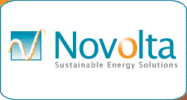 Distributed generation refers to the ability of a utility power network to be fed by more than one source, usually lots of smaller sources in decentralised locations. Distributed generation refers to the ability of a utility power network to be fed by more than one source, usually lots of smaller sources in decentralised locations.
Under normal circumstances, customers consume power, but an increasing trend is for some consumers to generate their own electricity and feed any surplus back to the utility network.
This is often the case where commercial users have a requirement for large quantities of electricity and heat. Because heat is produced in large amounts by conventional (steam powered) generators, the total efficiency of fuel use is greater, effectively reducing the cost of electricity.
Distributed generation also occurs where residential customers generate excess power onto the utility grid. Commonly using solar power, large numbers of small customers generate electricity onto the grid where it supports local demand. A large number of incentive schemes have been used worldwide to increase the number of distributed PV generators. Some of these schemes include:
Earlier programmes in Japan have put 10’s of thousand of solar systems onto the rooftops of Japanese houses.
Even with the schemes currently available in Australia, economically viable grid connected renewable energy systems are rare. Those that do stack-up usually involve additional benefits such as the use of heat generation.
How can it be used?
All of the sustainable energy solutions, as well as all conventional energy generation equipment can be utilised for a distributed generation source. Distributed generation can also be used to help support growing demand at the end of long transmission lines. Strictly speaking, multiple large generators on a state-wide or national network is a form of distributed generation, though the term is most often used for a larger number of small generators.
Where can it be used?
Because there is such a wide range of different generation schemes, distributed generation schemes are in operation ALL over the world.
Why do we use it?
Distributed generation avoids the power losses (up to 10%) of long distance transmission, and can save on infrastructure costs by offsetting the need to upgrade or replace transformers, powerlines and substations. Distributed generation can provide voltage stability and power factor correction, effectively “holding up” its end of the line to make power transfer more efficient and stable. Separate generation techniques have their own advantages and disadvantages. Which generation type best suits a given situation depends on many factors including cost, maintenance, reliability, size, location, climate, accessibility, local network power flow and regulations (or red tape).
What are the disadvantages?
Some of the disadvantages of distributed generation include:
- The distribution system needs adequate protection at the distributed generator to allow safe and stable power exchange
- Large distributed generators may require complicated signalling to facilitate stable power flows.
- Variability of renewable distributed generation
- High cost of fuel transport for conventional type generation (although this can also be a benefit if local fuels are available, such as land fill gas)
- Higher maintenance costs – maintaining multiple generators in multiple locations
- Higher operational costs as economy of scale not present at distributed generation sites
|
|

